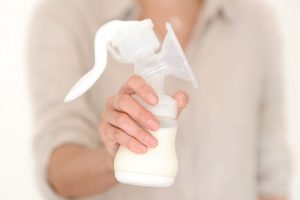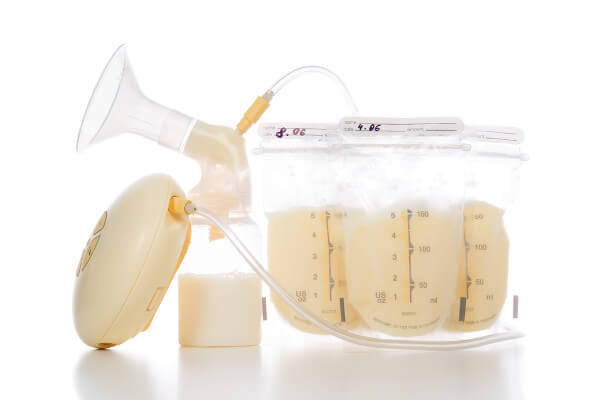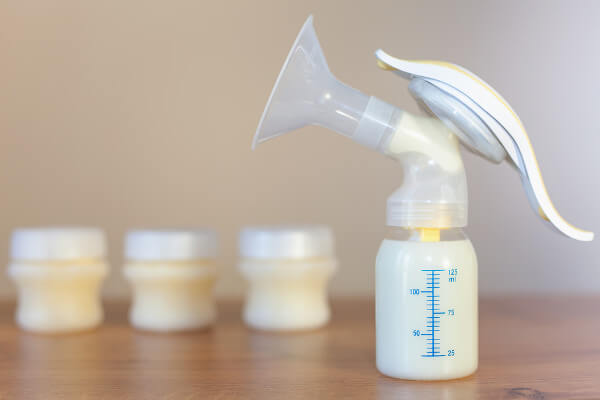How to Use a Breast Pump

Breast pumps are being used increasingly more often by new mothers. There are several reasons why a woman might choose to use a breast pump, such as for health concerns or work.
The truth is that it isn’t easy to adapt to either using a breast pump or, to a large extent, to the prejudice that comes along with it. In order to learn how to use a breast pump, a lot of practice is required.
In this article we want to provide some tips on how to use this device that we hope will be useful for you.
Who needs a breast pump?
While some prejudice does exist with regards to bottle feeding a baby, several facts must be taken into account. For example, bottle feeding doesn’t mean we’re going to harm the child in any way.
We know that breastfeeding has countless benefits. However, breast milk is more important than breastfeeding itself. That is, even when we don’t breastfeed the baby, it’s still essential that he receives his milk.
That said, let’s recognize that certain situations prevent us from breastfeeding our child. For various reasons, a mother might need to separate from her baby. Additionally, she might simply decide not to breastfeed.
With this in mind, the fact that the mother can’t or doesn’t want to breastfeed, doesn’t mean that she’ll stop feeding the baby breast milk.
Milk extraction is also an option applicable to special circumstances. It’s useful when mother and child are separated.
That’s why breast pumps are helpful when it comes to donating milk and helping babies in need. Breast pumps have been a valuable solution for more than 150 years.
Not all women need to use a breast pump, even if they buy it as a forethought. Only those who are going to return to work, or mothers of premature or sick babies typically use this device to feed their babies. However, each woman is free to choose to use it in any other context.
Breastfeeding is the link of love that makes our children healthy, strong, and happy
-Unknown Author-
How do you use a breast pump?

Extracting milk through this device isn’t easy at first. A lack of practice can prevent us from obtaining satisfactory results during our first few attempts.
The extraction can be slow and insufficient, not to mention how uncomfortable it can be for the mother. It is recommended that you approach this with patience and practice a lot; other aspects to consider include the following:
- When you’re about to use a breast pump, try to find a quiet environment that is free of tension. It’s known that a lot of noise or the presence of other people can prevent the production of milk.
- The baby himself stimulates the production of milk, so try to have the child close by, or use a photograph or object that belongs to him.
- Perform a chest massage before starting the extraction.
- Be careful not to hurt yourself. Even if you aren’t getting the results you expect. This activity shouldn’t cause you pain. If you feel any discomfort it’s because you aren’t using the device in the right way.
When can we extract milk using this device?
The timing and frequency for using a breast pump depend on the way we breastfeed. For example, if we never breastfeed, we should do the extraction more frequently, around three to four times a day.
In cases where we alternate the extraction with lactation, the instances of extraction must match the rhythm at which we breastfeed. That is, if we aren’t with the baby but it’s time to breastfeed, this is when we should use the extractor.
It’s advisable to do this in the morning. At night, breasts fill with milk, especially if the baby doesn’t breastfeed at night.
It’s also helpful when the baby feeds from only one breast, because we can then extract the milk from the other breast following the stimulation.
How should we clean and store the breast pump?

While the extractor doesn’t have any contact with the baby, it must still be sanitized in order for it to hold the milk safely. Also, while it’s in contact with the chest, it must be kept clean.
Before using this device, we must clean our hands. Along the same lines, we should also sterilize all of the components of the breast pump in order to avoid contamination.
In some cases, breast pumps come with disposable bags that can be filled directly from the extractor. The extracted milk can also be placed in separate containers.
The cleaning of the extractor is the same as that of a bottle. Since it has come in contact with milk, it must be sterilized in order to prevent the spread of bacteria.
The milk that we extract must be kept in the refrigerator or freezer, depending on the amount of time we’re going to store it.
If it isn’t going to be used in the next 24 hours, it is recommended that it be labeled with the date and then frozen. All containers where the milk is stored must also be sterilized.
Breast pumps are being used increasingly more often by new mothers. There are several reasons why a woman might choose to use a breast pump, such as for health concerns or work.
The truth is that it isn’t easy to adapt to either using a breast pump or, to a large extent, to the prejudice that comes along with it. In order to learn how to use a breast pump, a lot of practice is required.
In this article we want to provide some tips on how to use this device that we hope will be useful for you.
Who needs a breast pump?
While some prejudice does exist with regards to bottle feeding a baby, several facts must be taken into account. For example, bottle feeding doesn’t mean we’re going to harm the child in any way.
We know that breastfeeding has countless benefits. However, breast milk is more important than breastfeeding itself. That is, even when we don’t breastfeed the baby, it’s still essential that he receives his milk.
That said, let’s recognize that certain situations prevent us from breastfeeding our child. For various reasons, a mother might need to separate from her baby. Additionally, she might simply decide not to breastfeed.
With this in mind, the fact that the mother can’t or doesn’t want to breastfeed, doesn’t mean that she’ll stop feeding the baby breast milk.
Milk extraction is also an option applicable to special circumstances. It’s useful when mother and child are separated.
That’s why breast pumps are helpful when it comes to donating milk and helping babies in need. Breast pumps have been a valuable solution for more than 150 years.
Not all women need to use a breast pump, even if they buy it as a forethought. Only those who are going to return to work, or mothers of premature or sick babies typically use this device to feed their babies. However, each woman is free to choose to use it in any other context.
Breastfeeding is the link of love that makes our children healthy, strong, and happy
-Unknown Author-
How do you use a breast pump?

Extracting milk through this device isn’t easy at first. A lack of practice can prevent us from obtaining satisfactory results during our first few attempts.
The extraction can be slow and insufficient, not to mention how uncomfortable it can be for the mother. It is recommended that you approach this with patience and practice a lot; other aspects to consider include the following:
- When you’re about to use a breast pump, try to find a quiet environment that is free of tension. It’s known that a lot of noise or the presence of other people can prevent the production of milk.
- The baby himself stimulates the production of milk, so try to have the child close by, or use a photograph or object that belongs to him.
- Perform a chest massage before starting the extraction.
- Be careful not to hurt yourself. Even if you aren’t getting the results you expect. This activity shouldn’t cause you pain. If you feel any discomfort it’s because you aren’t using the device in the right way.
When can we extract milk using this device?
The timing and frequency for using a breast pump depend on the way we breastfeed. For example, if we never breastfeed, we should do the extraction more frequently, around three to four times a day.
In cases where we alternate the extraction with lactation, the instances of extraction must match the rhythm at which we breastfeed. That is, if we aren’t with the baby but it’s time to breastfeed, this is when we should use the extractor.
It’s advisable to do this in the morning. At night, breasts fill with milk, especially if the baby doesn’t breastfeed at night.
It’s also helpful when the baby feeds from only one breast, because we can then extract the milk from the other breast following the stimulation.
How should we clean and store the breast pump?

While the extractor doesn’t have any contact with the baby, it must still be sanitized in order for it to hold the milk safely. Also, while it’s in contact with the chest, it must be kept clean.
Before using this device, we must clean our hands. Along the same lines, we should also sterilize all of the components of the breast pump in order to avoid contamination.
In some cases, breast pumps come with disposable bags that can be filled directly from the extractor. The extracted milk can also be placed in separate containers.
The cleaning of the extractor is the same as that of a bottle. Since it has come in contact with milk, it must be sterilized in order to prevent the spread of bacteria.
The milk that we extract must be kept in the refrigerator or freezer, depending on the amount of time we’re going to store it.
If it isn’t going to be used in the next 24 hours, it is recommended that it be labeled with the date and then frozen. All containers where the milk is stored must also be sterilized.
All cited sources were thoroughly reviewed by our team to ensure their quality, reliability, currency, and validity. The bibliography of this article was considered reliable and of academic or scientific accuracy.
- Guía para las madres que amamantan. Guía dirigida a mujeres que desean amamantar o que amamantan a sus hijos, así como a sus parejas y familiares. AEPED. [En línea].
- Hernández Aguilar MT. La incorporación de la mujer al trabajo; extracción y conservación de la leche. En: AEPap ed. Curso de Actualización Pediatría 2004. Madrid: Exlibris Ediciones, 2004: p. 225-235.
This text is provided for informational purposes only and does not replace consultation with a professional. If in doubt, consult your specialist.








